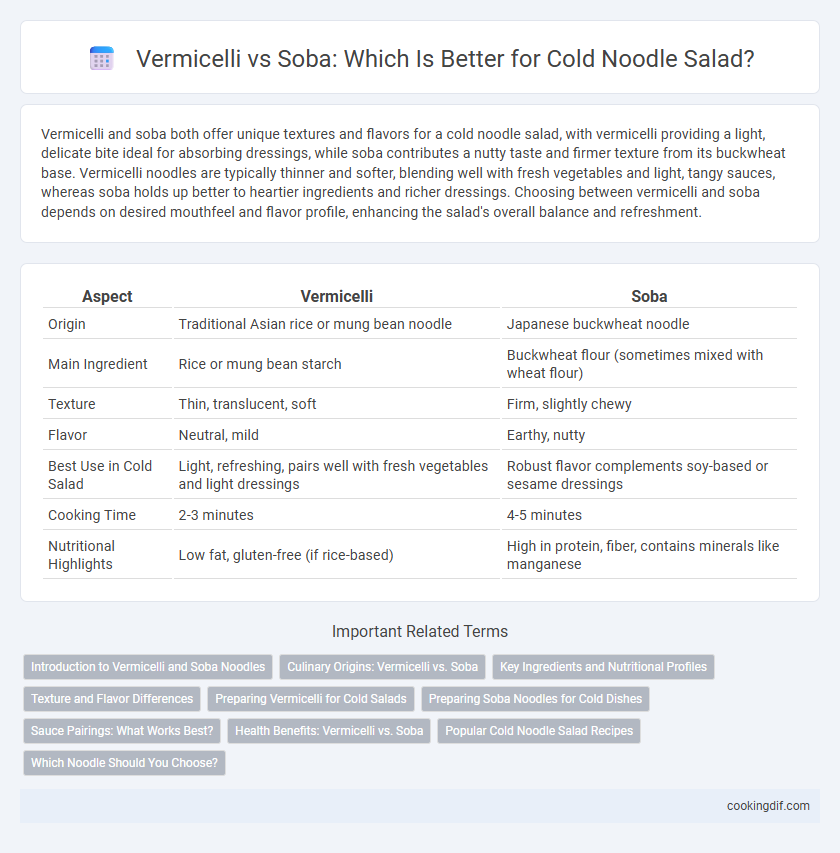Vermicelli and soba both offer unique textures and flavors for a cold noodle salad, with vermicelli providing a light, delicate bite ideal for absorbing dressings, while soba contributes a nutty taste and firmer texture from its buckwheat base. Vermicelli noodles are typically thinner and softer, blending well with fresh vegetables and light, tangy sauces, whereas soba holds up better to heartier ingredients and richer dressings. Choosing between vermicelli and soba depends on desired mouthfeel and flavor profile, enhancing the salad's overall balance and refreshment.
Table of Comparison
| Aspect | Vermicelli | Soba |
|---|---|---|
| Origin | Traditional Asian rice or mung bean noodle | Japanese buckwheat noodle |
| Main Ingredient | Rice or mung bean starch | Buckwheat flour (sometimes mixed with wheat flour) |
| Texture | Thin, translucent, soft | Firm, slightly chewy |
| Flavor | Neutral, mild | Earthy, nutty |
| Best Use in Cold Salad | Light, refreshing, pairs well with fresh vegetables and light dressings | Robust flavor complements soy-based or sesame dressings |
| Cooking Time | 2-3 minutes | 4-5 minutes |
| Nutritional Highlights | Low fat, gluten-free (if rice-based) | High in protein, fiber, contains minerals like manganese |
Introduction to Vermicelli and Soba Noodles
Vermicelli noodles, thin and translucent, are typically made from rice or mung bean starch, offering a light and delicate texture perfect for cold noodle salads. Soba noodles, crafted from buckwheat flour, provide a nutty flavor and slightly firmer bite, complementing chilled dishes with a wholesome, earthy taste. Both noodles are versatile in cold preparations but differ significantly in ingredients, texture, and subtle taste profiles, impacting the overall salad experience.
Culinary Origins: Vermicelli vs. Soba
Vermicelli, thin rice noodles originating from Southeast Asian cuisine, are prized for their light texture and ability to absorb vibrant dressings in cold noodle salads. Soba, made from buckwheat flour in Japan, offers a nutty flavor and firm bite, reflecting its historical role in Japanese culinary tradition. Both noodles bring distinct cultural essences and textures that define their use in refreshing cold dishes.
Key Ingredients and Nutritional Profiles
Vermicelli noodles, made primarily from rice or mung bean starch, offer a light texture and are gluten-free, making them ideal for cold noodle salads. Soba noodles consist of buckwheat flour, providing a nutty flavor along with higher protein and fiber content compared to vermicelli. Nutritionally, soba noodles deliver more complex carbohydrates and essential minerals like manganese, while vermicelli is lower in calories but lacks significant protein and fiber.
Texture and Flavor Differences
Vermicelli noodles offer a thin, smooth texture with a mild, slightly sweet flavor that absorbs dressings well, making them ideal for cold noodle salads. Soba noodles have a firmer, slightly chewy texture with a nutty, earthy taste derived from buckwheat flour, providing a more robust flavor profile. The choice between vermicelli and soba affects both the mouthfeel and the overall taste experience of the cold noodle salad.
Preparing Vermicelli for Cold Salads
Vermicelli, made from rice or mung bean starch, offers a light, translucent texture perfect for cold noodle salads, absorbing dressings without overpowering flavors. Preparing vermicelli involves soaking or briefly boiling the noodles until tender, then rinsing under cold water to stop cooking and prevent clumping. This method ensures vermicelli remains delicate and refreshing, contrasting with the nuttier, chewier buckwheat soba noodles often used in Japanese cold salads.
Preparing Soba Noodles for Cold Dishes
Soba noodles require careful rinsing under cold water immediately after boiling to remove excess starch and prevent clumping, ensuring a smooth texture in cold noodle salads. Chilling soba in icy water firms up the noodles, enhancing their chewy bite, which contrasts with the lighter texture of vermicelli. Properly prepared soba maintains its nutty flavor and structural integrity, making it ideal for refreshing cold dishes.
Sauce Pairings: What Works Best?
Vermicelli's light, slightly chewy texture pairs exceptionally well with tangy, citrus-based sauces like lime and fish sauce or peanut-based dressings, enhancing its mild flavor in cold noodle salads. Soba, made from buckwheat, offers a nuttier taste that complements savory soy, sesame oil, and ginger-infused sauces, providing a richer umami profile. For optimal sauce pairing, vermicelli suits bright, fresh dressings while soba excels with robust, deeply flavored condiments in chilled preparations.
Health Benefits: Vermicelli vs. Soba
Vermicelli, made primarily from rice or mung bean starch, is gluten-free and low in fat, making it a suitable option for those with gluten sensitivities or seeking a light carbohydrate source. Soba noodles, crafted from buckwheat flour, contain higher protein content, essential amino acids, and beneficial antioxidants, supporting heart health and improved digestion. Incorporating soba into cold noodle salads enhances fiber intake and essential minerals like manganese, zinc, and magnesium, contributing to a more nutrient-rich and satiating meal.
Popular Cold Noodle Salad Recipes
Vermicelli and soba noodles each bring unique textures and flavors to popular cold noodle salad recipes. Vermicelli, made from rice or mung bean starch, offers a delicate, smooth texture that absorbs dressings well, making it ideal for refreshing Asian-inspired salads like Thai glass noodle salad. Soba, crafted from buckwheat, provides a nutty flavor and firmer bite, commonly featured in Japanese cold soba salads that combine soy-based dressings, cucumber, and scallions for a wholesome, protein-rich meal.
Which Noodle Should You Choose?
Vermicelli offers a light, delicate texture perfect for absorbing vibrant dressings in cold noodle salads, making it an ideal choice for a refreshing bite. Soba noodles provide a nutty flavor and a firmer texture with added nutritional benefits from buckwheat, enhancing the salad's heartiness. Choose vermicelli for a softer, more neutral base or soba for a robust, healthful twist in your cold noodle salad.
Vermicelli vs Soba for cold noodle salad Infographic

 cookingdif.com
cookingdif.com